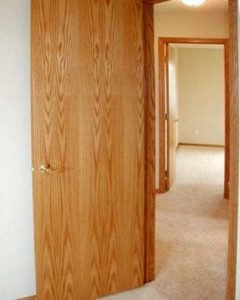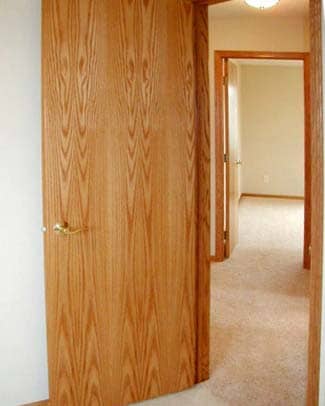Table of Contents
In this article, we will discuss flush doors.
A flush door contains a smooth surface and is made by sandwiching plywood or blackboard over a light timber frame. The hollow part of the middle of these doors is filled with cardboard/hardwood. They can be done with either laminates or veneers.
1. Flush Door
A flush door has a smooth surface, if water were to be spread on its body, water would simply pour off its body without collecting.
The entrance is the first place where visitors visit, the entrance creates a lasting impression on visitors’ brains but somehow doors stay unnoticed either they are elegantly used.
Doors are an essential need and components in every building and should not only be beautiful and satisfying but also contain properties like durability, strength, water & heat resistance, and they should not bend with time.
2. Types of Flush Doors
There are 3 flush door types available in the market that are as follows:
a. Solid Core Flush Doors
b. Hollow-core flush doors
c. Cellular core flush door
a. Solid Core Flush Doors
Solid-core flush doors are very famous because of their properties. The wood which is utilized in these doors is majorly hard and has a mineral composition. The various combinations of particle board, laminated core, cross band, face wood veneer, blockboard, etc. are utilized to prepare these doors. The width of these doors should be greater than 7.5 cm of stiles, top and bottom rails.
This type of door also gives sound insulation features. The frame of these doors is prepared of timber wood and hardwood lipping is performed around the framing to give more strength and durability to the door. The width of wood lipping must be equal to the thickness of the core.
They are weighty and contain good strength. Due to their high strength and stability, these doors are majorly utilized as exterior doors for homes and other features.
The cost of Solid-core flush doors available in the market is 220-250 Rs. per square feet vary on the quality of laminated materials.
Advantages of Solid Core Flush Doors
a. These doors are not pretentious by any environmental fluctuation.
b. These doors are eco-friendly, waterproof, and good sound insulators as well.
c. These doors are dimensionally precise and stable.
d. These doors are high long-lasting and contain a high screw supporting ability.
e. These doors can be effortlessly cleaned so need less maintenance.
f. These doors are good in quality so they are durable.

b. Hollow Core Flush Doors
Hollow-core flush doors are hollow from the inner with a holding system mainly a honeycomb support system utilized in this door. Same to the solid core flush door, the framing of stiles, top, bottom, and intermediate rails must be greater than 7.5 cm in width. The frame includes stiles along with top, intermediate & bottom rails, and installing wooden battens on the rails for filling openings between stiles and rails.
In this door, the thickness of plywood must be always greater than 6 mm. Plywood sheets and face veneers are attached to the core under pressure. These doors are very light in weight as compared to the other types but not as strong as solid core flush doors.
Hollow-core flush doors are found in the market at the cost of 180-200 Rs. per square feet.
Advantages of Hollow-core Flush Doors
a. Flush doors are light in weight so they can be effortlessly transported and used.
b. The body of this door has the capacity to prevent stains, scratches, and crashes.
c. These doors can be prepared in any shape and are easy to fit.
d. These doors provide a variety of designs and garnish finishes.
e.This is effortlessly prepared and cheap.

c. Cellular Core Flush Doors
The cellular core flush doors frames are built by attaching plywood battens and they are more than 25 mm wide. The shutter is prepared by attaching plywood sheets and face veneers on both the faces of the core under pressure.
In this type of door, the width of the plywood sheet must be always not less than 3 mm. As these doors are chemically treated well and vacuum pressed, thus they own heat and water withstand features.
The cost of a cellular core flush door is 150-170 Rs. per square feet.
Advantages of Cellular Core Flush Doors
a. Cellular core flush doors come with a locked area on both sides for ease of installation.
b. These doors allow the homeowners to get the doors customized as per their requirements and choice.
c. These doors provide an attractive, warm, and traditional appearance.
d. This door requires less maintenance.

3. Advantages of Flush Doors
There are many advantages of flush doors which are as follows:
a. The designs of flush doors are very simple so they are inexpensive in cost and easily found.
b. These doors are stiff, impact-resistant, and contain high strength.
c. These doors never twist with time, as they are prepared of rectangular softwood blocks on the inner.
d. It is attractive, traditional, and rich in appearance.
e. These doors are not weighty in weight as regular plywood doors and can be effortlessly fitted and used every day.
f. These doors can be utilized in both areas inner and outer as well.
g. These doors are weatherproof by applying varnish and decay-proof.
h. Because of chemical treatment these doors are termite and fungi-free.
i. The material price in preparing these doors is very low and hence, these doors are cheaper.
4. Disadvantages of Flush Doors
There are many disadvantages of flush doors which are as follows:
1. It is factory-prepared and hence the desired or perfect size of the door opening must be provided, as the following alternations are very hard.
2. The plywood-covered flush door cannot be utilized where they will be opened to rain and the sun.
3. This door is heavyweight. So it is very difficult to carry, transport, handle and fit in your building.
4. They are hard to repair on the top veneer or laminate or plywood starts dividing into layers due to temperature, moisture, etc effects.
| Read Also: Varnish |

